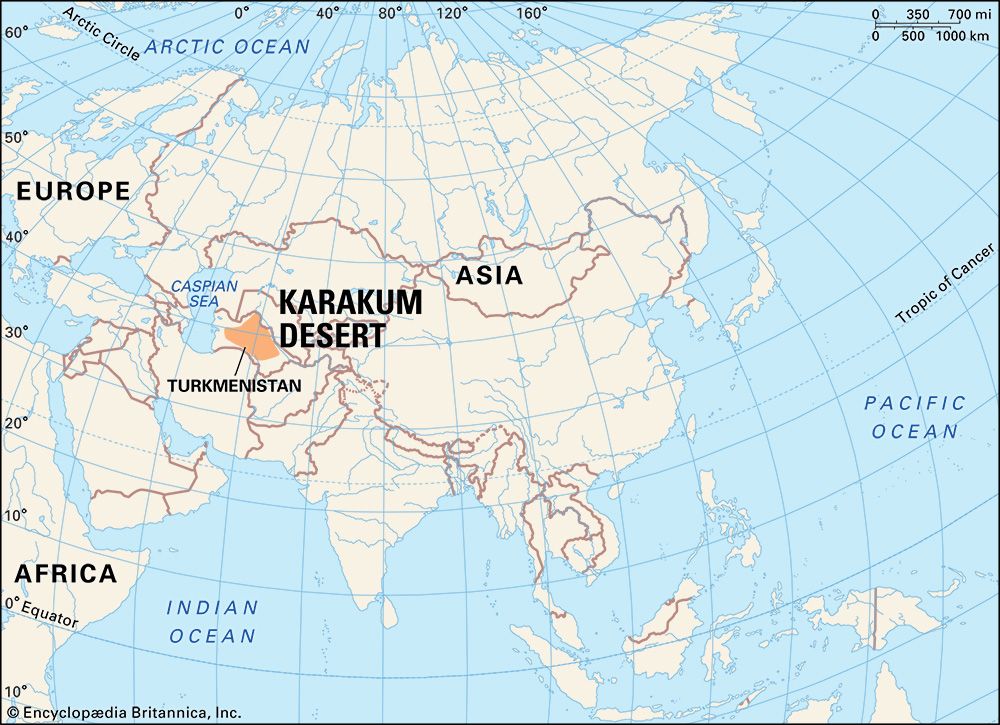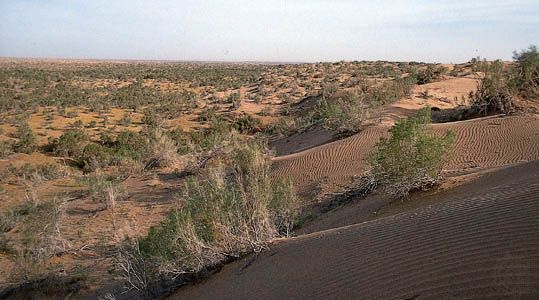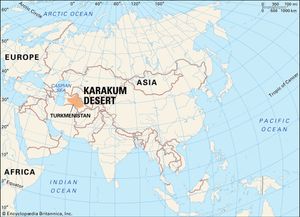Karakum Desert
- Also spelled:
- Kara-Kum
- Turkmen:
- Garagum or Gara Gum (“Black Sand”)
- Russian:
- Karakumy
Karakum Desert, great sandy region in Central Asia. It occupies about 70 percent of the area of Turkmenistan. Another, smaller desert in Kazakhstan near the Aral Sea is called the Aral Karakum.
Physical features
Physiography
The Turkmen Karakum is approximately 135,000 square miles (350,000 square km) in area, extending some 500 miles (800 km) from west to east and 300 miles (500 km) from north to south. It is bordered on the north by the Sarykamysh Basin, on the northeast and east by the Amu Darya (ancient Oxus River) valley, and on the southeast by the Garabil uplands and Badkhyz steppe region. In the south and southwest the desert runs along the foot of the Kopet-Dag Mountains, and in the west and northwest it borders the course of the ancient valley of the Uzboy River. It is divided into three parts: the elevated northern Trans-Unguz Karakum; the low-lying Central Karakum; and the southeastern Karakum, through which runs a chain of salt marshes. Along the border of the Trans-Unguz and Central Karakum runs the Unguz chain of saline, isolated, eolian (wind-formed) hollows.
The surface of the Trans-Unguz Karakum has been eroded by violent winds. The plain of the Central Karakum runs from the Amu Darya to the Caspian Sea along the same incline as the river. The height of wind-accumulated, half-overgrown sand ridges ranges from 250 to 300 feet (75 to 90 metres), depending on age and wind velocity. Somewhat less than 10 percent of the area consists of barchans (crescent-shaped dunes), some of them 30 feet (9 metres) or more in height. There are numerous interdune depressions (takyr), which are covered by clay deposits up to 30 feet (9 metres) thick and act as catchment basins for the region’s scanty precipitation; the water collected in these basins makes it possible to grow such fruits as melons and grapes. Saline areas called solonchaks are also formed by the evaporation of subsoil water.
Geology
Some 30 million years ago the entire Karakum region was covered by the sea. Orogenic (mountain-building) processes in the southern part of the Turan Plain resulted in a gradual diminishing of the sea and, ultimately, in its disappearance. Subsequently, the Amu Darya flowed across the Karakum, changing its bed from time to time and depositing large amounts of alluvial sediments (mostly sand and clay). The Karakum sands now contain some 40 different minerals brought down from the mountains to the southeast. After the Amu Darya changed its course and turned to the north to drain into the Aral Sea, the surface of the Karakum came to be shaped largely by eolian processes, which account for the present diversity of the desert’s landforms.















